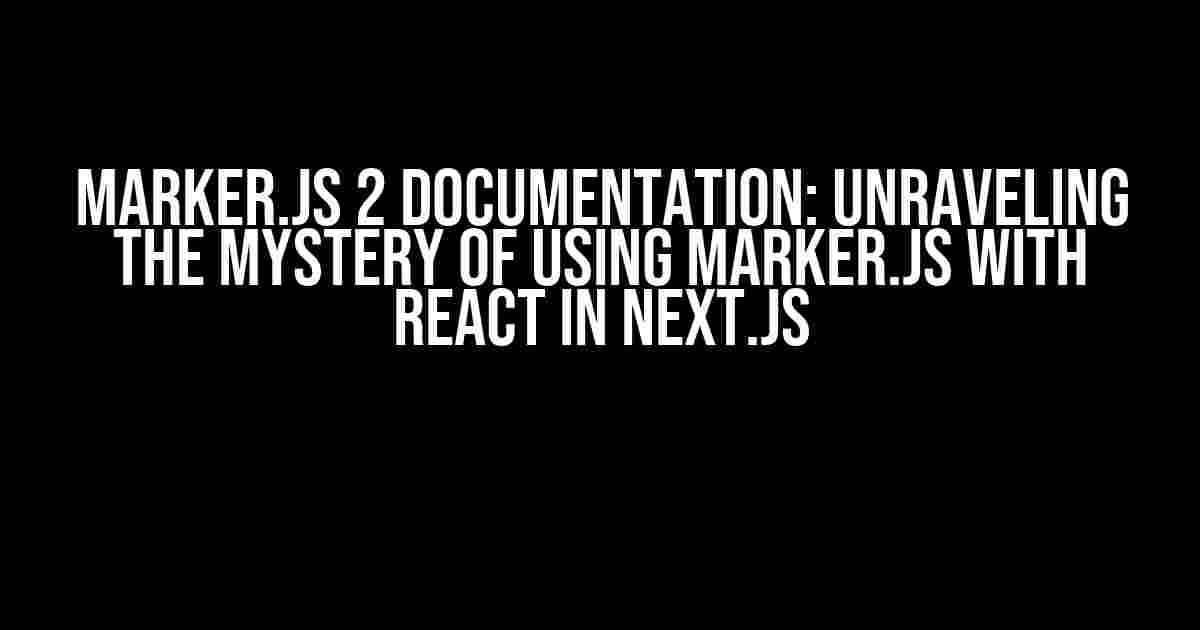Are you tired of wrestling with Marker.js 2 and React in Next.js? You’re not alone! Many developers have stumbled upon the same hurdle, only to find themselves lost in a sea of frustration. But fear not, dear reader, for we’re about to embark on a journey to tame the beast and make Marker.js work seamlessly with React in Next.js.
What is Marker.js 2?
Marker.js 2 is an incredible library that allows you to create interactive, web-based graphics and diagrams. With its impressive set of features and intuitive API, it’s no wonder developers are eager to integrate it into their projects. However, when it comes to using Marker.js with React in Next.js, things can get a bit… complicated.
The Problem: Why Marker.js 2 Doesn’t Play Nice with React in Next.js
The main issue lies in the way Marker.js 2 expects to interact with the DOM. You see, Marker.js 2 relies on direct DOM manipulation, which can clash with React’s virtual DOM. Next.js, being a server-side rendering (SSR) framework, adds another layer of complexity to the mix. The result? A perfect storm of confusion and errors.
But Fear Not, Dear Developer!
With a solid understanding of the underlying issues and some clever workarounds, we can successfully integrate Marker.js 2 with React in Next.js. So, buckle up and let’s dive into the solutions!
Step 1: Installing Marker.js 2 and Configuring React
Before we begin, ensure you have installed Marker.js 2 via npm or yarn:
npm install marker.jsNext, create a new React component that will house your Marker.js 2 diagram:
import React from 'react';
import { Container, Diagram } from 'markerjs';
const MyDiagram = () => {
return (
<Container>
<Diagram>
<!-- Your diagram elements go here -->
</Diagram>
</Container>
);
};
export default MyDiagram;Step 2: Handling SSR and Direct DOM Manipulation
To overcome the issues with SSR and direct DOM manipulation, we’ll employ a clever trick: using React’s `useEffect` hook to inject the Marker.js 2 diagram into the DOM after the component has mounted.
import React, { useEffect, useRef } from 'react';
import { Container, Diagram } from 'markerjs';
const MyDiagram = () => {
const diagramRef = useRef(null);
useEffect(() => {
const container = diagramRef.current;
const diagram = new Diagram(container);
// Configure your diagram elements here
diagram.addNode({
id: 'node-1',
text: 'Hello World!'
});
return () => {
diagram.destroy();
};
}, [diagramRef]);
return (
<div ref={diagramRef} />
);
};
export default MyDiagram;Why This Works
By using `useEffect`, we ensure that the Marker.js 2 diagram is created and injected into the DOM only after the component has mounted. This sidesteps the issues with SSR and allows Marker.js 2 to manipulate the DOM as needed.
Step 3: Integrating with Next.js
Now that we’ve got our Marker.js 2 diagram working with React, let’s integrate it with Next.js. Create a new page in your Next.js project:
import MyDiagram from '../components/MyDiagram';
const DiagramPage = () => {
return (
<div>
<h1>Marker.js 2 Diagram</h1>
<MyDiagram />
</div>
);
};
export default DiagramPage;Voilà!
That’s it! You should now have a fully functional Marker.js 2 diagram working seamlessly with React in Next.js.
Troubleshooting and Best Practices
While the above solution should get you started, there are some additional tips and tricks to keep in mind:
- SSR and Hydration: Make sure to handle SSR and hydration correctly by using React’s `useEffect` hook and injecting the Marker.js 2 diagram into the DOM after the component has mounted.
- Diagram Configuration: Be mindful of the Marker.js 2 diagram configuration and ensure it’s initialized correctly. You may need to adapt the configuration to fit your specific use case.
- Performance Optimization: As Marker.js 2 diagrams can be computationally intensive, consider implementing performance optimization techniques, such as lazy loading or code splitting, to improve page load times.
Conclusion
In conclusion, using Marker.js 2 with React in Next.js requires a solid understanding of the underlying complexities and some creative problem-solving. By following the steps outlined in this article, you should be able to overcome the hurdles and create stunning, interactive diagrams that delight your users.
Remember, the key to success lies in handling SSR and direct DOM manipulation correctly, while also configuring Marker.js 2 to work in harmony with React and Next.js. With patience, persistence, and a dash of creativity, you’ll be well on your way to creating breathtaking visualizations that take your project to the next level.
| Marker.js 2 Version | React Version | Next.js Version |
|---|---|---|
| 2.1.0 | 17.0.2 | 12.0.0 |
Note: The above table outlines the versions used in this article. Ensure you’re using compatible versions of Marker.js 2, React, and Next.js to avoid any potential issues.
Frequently Asked Questions
-
Q: Why doesn’t Marker.js 2 work with React in Next.js out of the box?
A: Marker.js 2 relies on direct DOM manipulation, which can clash with React’s virtual DOM. Next.js, as an SSR framework, adds an extra layer of complexity to the mix.
-
Q: Can I use Marker.js 2 with other React libraries or frameworks?
A: While this article focuses on Next.js, the principles outlined can be adapted to work with other React libraries and frameworks. However, be prepared to handle potential differences in SSR and DOM manipulation.
-
Q: How can I optimize the performance of my Marker.js 2 diagram?
A: Implement performance optimization techniques, such as lazy loading, code splitting, or memoization, to improve page load times and overall user experience.
By following this comprehensive guide, you should be well-equipped to overcome the challenges of using Marker.js 2 with React in Next.js. Happy coding, and may your diagrams be as brilliant as your imagination!
Here are 5 Questions and Answers about “marker.js 2 Documentation: Using marker.js with React is not working with Next.js”:
Frequently Asked Question
Are you having trouble using marker.js with React in your Next.js project? Don’t worry, we’ve got you covered! Check out our FAQs below to troubleshoot the issue.
Why is marker.js not working with my Next.js project?
This might be because marker.js uses a different rendering mechanism than Next.js. To fix this, make sure to wrap your marker.js component with the `React.Fragment` component, like this: `
Do I need to use a specific version of marker.js with Next.js?
Yes, you’ll need to use marker.js version 2.x or later to ensure compatibility with Next.js. Older versions might not work as expected. Make sure to check the marker.js documentation for the latest version and installation instructions.
How do I configure marker.js to work with server-side rendering (SSR) in Next.js?
To use marker.js with SSR in Next.js, you’ll need to disable SSR for the specific page or component that uses marker.js. You can do this by adding `getStaticProps` or `getServerSideProps` to your page component and setting `revalidate` to `false`. This will allow marker.js to work correctly on the client-side.
Why am I getting a “Cannot read property ‘localStorage’ of undefined” error with marker.js in Next.js?
This error occurs because marker.js tries to access the `localStorage` object, which is not available on the server-side. To fix this, you can wrap the marker.js component with a check to ensure it only runs on the client-side, like this: `if (typeof window !== ‘undefined’) { /* marker.js component */ }`.
Is there an official marker.js documentation for using it with Next.js?
Unfortunately, there isn’t an official marker.js documentation specifically for using it with Next.js. However, the marker.js community has created some unofficial guides and tutorials that can help you get started. You can also check out the Next.js documentation for more information on using third-party libraries with Next.js.


